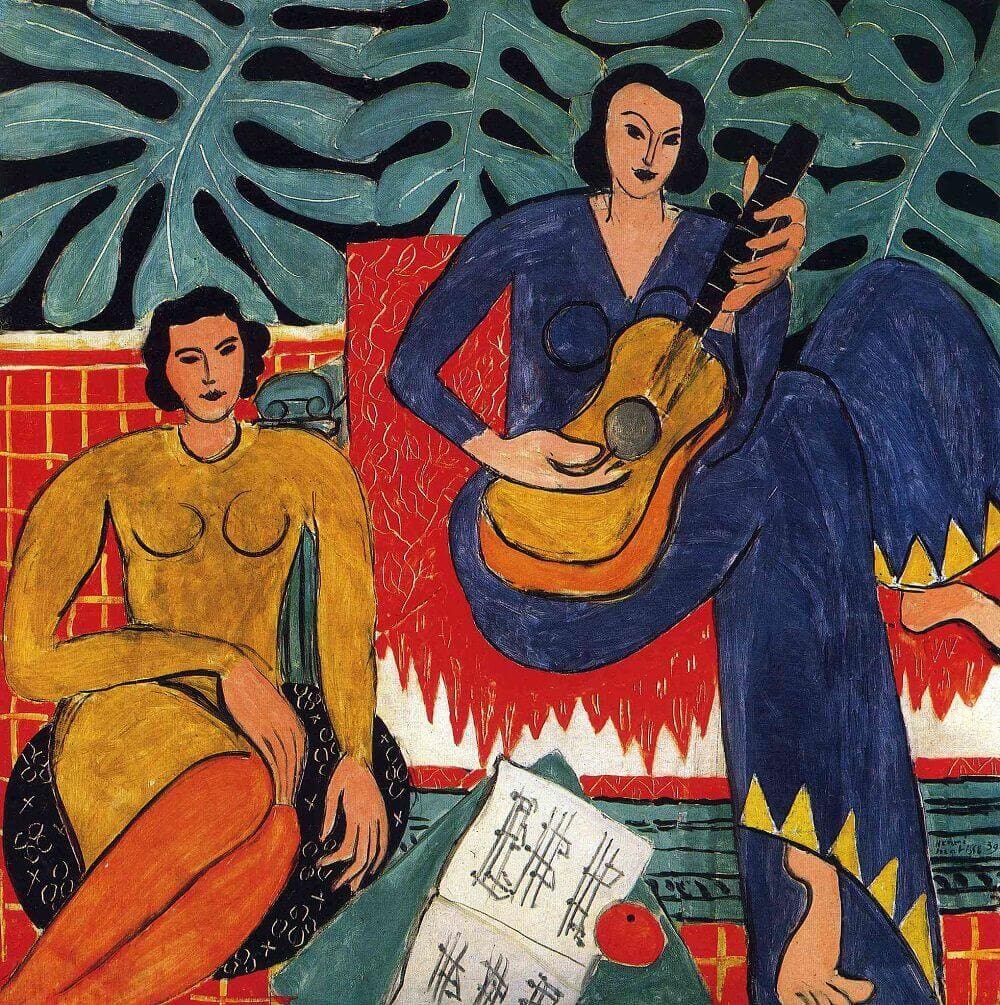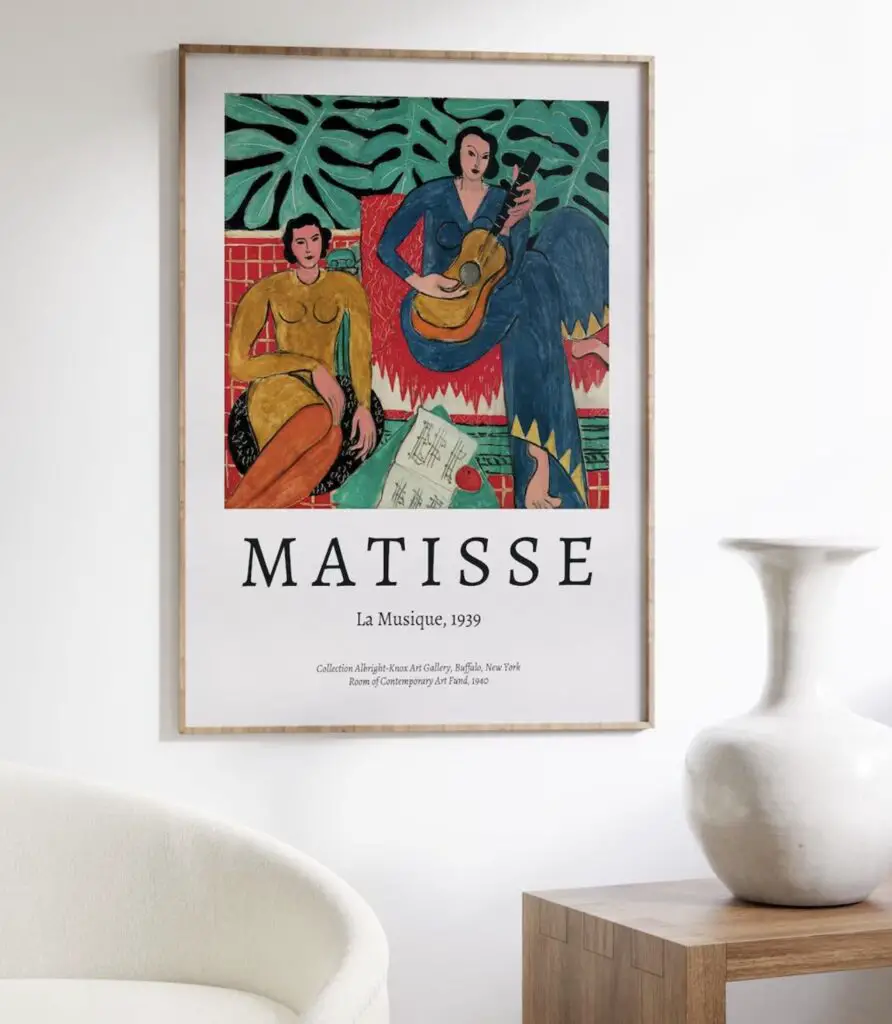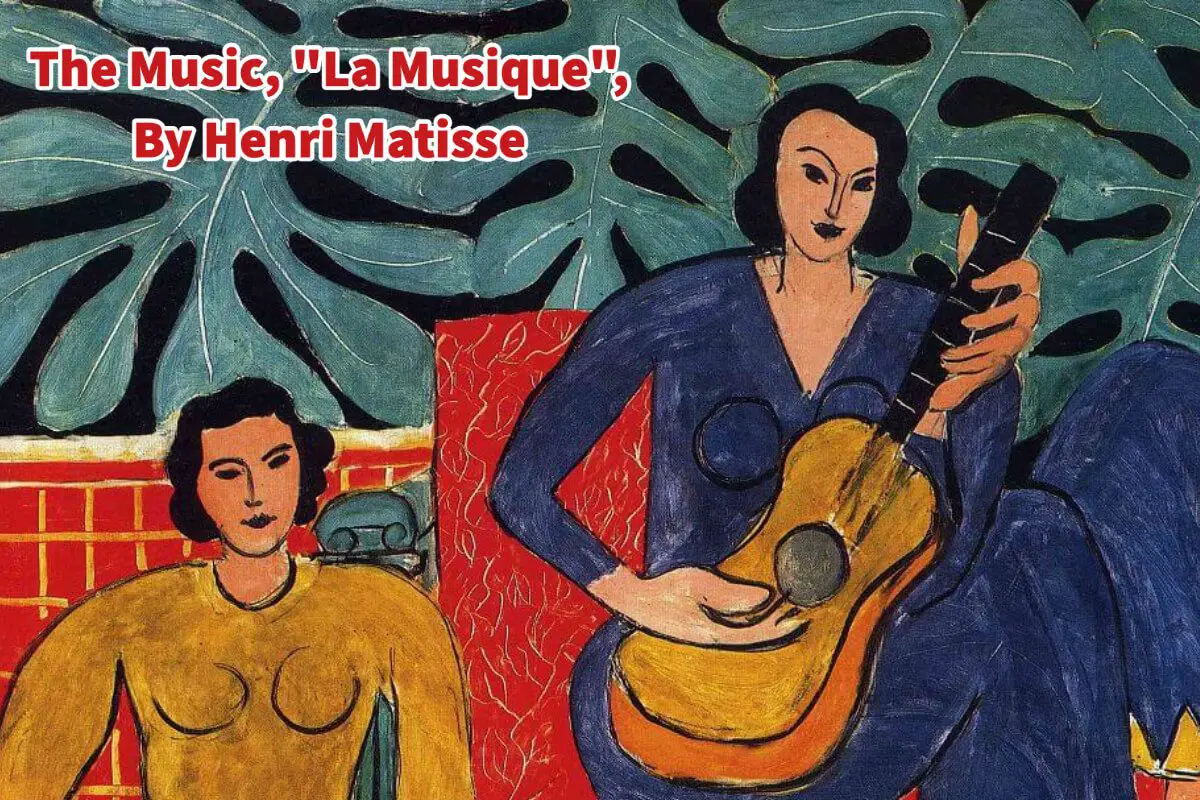Henri Matisse, a pioneering French artist of the 20th century, is renowned for his revolutionary contributions to modern art. He is widely regarded as a leader of the Fauvist movement, a group of artists who defied traditional artistic norms by using bold, vivid colors and simplified forms to express their emotions.
One of Matisse’s most significant and iconic works is “The Music” (1910). This oil painting on canvas encapsulates the essence of his artistic vision and creative evolution. The painting features three female figures, seemingly musicians, in a harmonious and rhythmic composition. Matisse’s use of vibrant colors, energetic brushstrokes, and the absence of realistic representation exemplifies the Fauvist style.
Table of Contents
About Henri Matisse And La Musique, The Music 1910

Henri Matisse’s renowned masterpiece, “La Musique,” painted in 1910, is a testament to his artistic brilliance. This majestic work was conceived at the behest of Sergei Shchukin, who proudly displayed it alongside “Dance” in the grand staircase of his Moscow abode.
Matisse took an unconventional approach in crafting this painting, eschewing any preparatory sketches. Consequently, “La Musique” bears evident signs of alterations, effectively serving as a roadmap to Matisse’s journey toward achieving his envisioned aesthetic.

Like “The Dance,” “La Musique” encapsulates Matisse’s aspiration to portray the ultimate human attainment of completeness through creative immersion. The artist’s philosophy of composition hinged on “the art of arranging decoratively the various elements at a painter’s disposal for the expression of his feelings.”
He aimed to give his paintings an air of effortless beauty, although the unity and rhythm he strived for were far from easy to attain. Every element had to be meticulously arranged to form a cohesive whole.
In La Musique, Matisse Repeats Shapes
In “La Musique,” Matisse repeats specific shapes to build a rhythmic pattern throughout the painting. Horizontal and vertical lines provide a structural framework for the curves and diagonals, while a reasonable balance of color further enhances the composition.
Matisse’s primary challenge was the harmonious unity between the two depicted figures.
The artist’s ingenious use of various techniques helps bind the two figures into a cohesive entity: a diagonal line originating from the legs of the figure on the left continues upwards, echoing in the guitar’s structure, which in turn mirrors the colors of the left-hand woman’s dress and legs.
The right arms of both figures mirror each other in pose, and the left arm of one figure aligns with the right leg of the other. Both women’s hairstyles and facial features bear a striking resemblance, thus reinforcing the visual harmony.
Matisse Wanted To Create An Aura And Balance
Matisse’s ultimate aspiration, as he once expressed, was to cultivate “an art of balance, of purity and serenity, devoid of troubling or depressing subject matter.” He envisioned his art as a salve for all – whether a laborer, businessman, or scholar, providing a respite akin to the comfort of a good armchair after a long day’s physical fatigue.

“La Musique” effectively embodies this artistic philosophy, showcasing Matisse’s ability to transform a canvas into a source of soothing, calming mental influence.
Matisse’s genius extends beyond just the visual elements of “La Musique”; his strategic placement of the elements reinforces the unity of the composition. The symmetrical arrangement of the figures and objects, their synchrony, and their echoing shapes and colors all contribute to a rhythmic flow of visual music that aligns with the painting’s title.
La Musique Is Signature Of Matisse Style
“La Musique” bears the signature of Matisse’s style – his unparalleled ability to use color as a vehicle for expressing emotion. The contrast between the vivid red of the central figure’s dress and the cool blue of the guitar player’s dress helps to heighten the dynamism within the painting.
This also balances the painting, maintaining the equilibrium Matisse so admired.
Despite the apparent simplicity, every stroke in “La Musique” is carefully thought out and meticulously placed, testifying to Matisse’s commitment to creating an art that appears effortless.
Yet, beneath the simplicity lies a complex network of artistic decisions, every shape, and color arranged and rearranged until a perfect balance is achieved.

Matisse Believed That Art Can Sooth And Calm
This commitment to balance and serenity goes beyond the canvas; it reflects Matisse’s belief in the soothing power of art. Matisse’s mission wasn’t just to create visually appealing work but to forge an immersive experience that provided an oasis of tranquility amidst the tumult of life.
For Matisse, the goal was to create art that provided “relaxation from physical fatigue,” similar to a comforting armchair, serving all men and women, regardless of their social or professional standing.
“La Musique” is a symphony in paint, a testament to Matisse’s skill and vision. This painting, created without preliminary sketches, beautifully reflects Matisse’s journey to his artistic truth. It’s not just an expression of Matisse’s feelings but a work designed to evoke emotion, relaxation, and peace in the viewer, fulfilling Matisse’s aspiration to create universally soothing art.
It manifests his belief that art should be an accessible source of comfort and tranquility, capable of offering solace to any observer, whether a laborer, a business person, or a writer.
Frequently Asked Questions
What is the significance of “The Music” in Henri Matisse’s body of work?
“The Music” is considered one of Matisse’s masterpieces, showcasing his transition to the Fauvist style. Its significance lies in its departure from traditional representation and the exploration of color and form as expressive elements.
Who are the figures depicted in “The Music,” and what role do they play in the composition?
The painting features three female figures assumed to be musicians. Their role is to convey a sense of harmony and rhythm, contributing to the overall musical theme of the artwork.
How does Matisse’s use of color in “The Music” reflect the Fauvist movement?
Matisse’s bold and vibrant color choices, typical of the Fauvist style, are evident in “The Music.” The expressive use of color serves to convey emotions and create a dynamic visual impact rather than adhering to realistic representation.
What techniques did Matisse employ in creating “The Music,” and how do they contribute to the overall composition?
Matisse utilized energetic brushstrokes and a simplified form to create a visually engaging composition. These techniques contribute to the painting’s sense of movement and rhythm, aligning with the Fauvist emphasis on spontaneity.
How does “The Music” reflect Matisse’s interest in the relationship between art and music?
Matisse was inspired by the parallels between visual art and music. “The Music” embodies this connection through its rhythmic composition and the suggestion of a musical performance by the depicted figures.
What is the historical context of “The Music,” and how does it relate to the broader art scene of the early 20th century?
Created in 1910, “The Music” emerged during a period of artistic experimentation. It reflects the Fauvist movement’s rebellion against traditional artistic conventions and contributes to the broader narrative of early 20th-century avant-garde art.
Are there any known interpretations or symbolic meanings associated with the elements in “The Music”?
While Matisse’s work often invites varied interpretations, specific symbolic meanings in “The Music” remain open to personal perception. Some suggest the painting represents the joy and energy of the artistic process itself.
How did Matisse’s artistic evolution contribute to the creation of “The Music”?
“The Music” marks a significant point in Matisse’s artistic journey, showcasing his departure from more conventional styles toward the bold and expressive Fauvist approach. It reflects his ongoing exploration of new artistic possibilities.
Where is “The Music” currently located, and is it accessible to the public?
As of my knowledge cutoff in 2022, “The Music” is part of the collection at the Hermitage Museum in St. Petersburg, Russia. Accessibility to the public may vary, and it’s advisable to check with the museum for the latest information.
How has “The Music” influenced subsequent generations of artists or contributed to the legacy of Henri Matisse?
“The Music” remains a key work in Matisse’s legacy, influencing later artists and contributing to the ongoing dialogue about the expressive power of color and form in art. Its impact can be seen in the continued exploration of non-representational and emotionally charged compositions in modern art.
Anita Louise Art is dedicated to art education, great artists, and inspiring others to find and create their art. We love art that uplifts and inspires. #ArtToMakeYouSmile! #ArtToMakeYouHappy!
If you want to see any of my art, you can find out more by clicking here. If you are interested in what inspires me and my paintings, you can discover more by clicking here.
We have a free newsletter and would love you to be part of our community; you can subscribe to the newsletter by clicking here. If you have any questions, I would be happy to talk to you anytime. You can reach me, Anita, by clicking here.
Subscribe to our Anita Louise Art YouTube Channel with great videos and information by clicking here.
Join us for our podcast “5 Minutes With Art.” Spend just 5 minutes a week with us to discover and learn about great art and artists. You can find out more about our podcast by clicking here.
Related Questions
Discovering Van Gogh: Van Gogh Museum Amsterdam
The Van Gogh Museum in Amsterdam is a world-renowned cultural institution that attracts art lovers and enthusiasts from around the globe. It is home to the most extensive collection of works by the legendary Dutch artist Vincent van Gogh. Visitors can explore Van Gogh’s fascinating life and career through a diverse collection of over 200 paintings, 500 drawings, and 700 letters. The museum constantly has new and exciting collections that also reflect upon the work and life of Vincent Van Gogh.
By clicking here, you can discover more by reading Discovering Van Gogh: Van Gogh Museum Amsterdam.
Clyfford Still Museum In Denver, All About
The best place in the world to see and get inspired by Clyfford Stills and his artwork is the Clyfford Still Museum in Denver, Colorado. The museum has the bulk of the Abstract Expressionism artist’s works of art housed at their museum. The museum only shows and displays works of art by Clyfford Still.
By clicking here, you can learn more by reading Clyfford Still Museum In Denver, All About.
Louvre Museum Facts, Our Top 7 Facts
The Louvre is the largest museum globally; it was once built as a fortress to protect the city of Paris. Under the French Republic’s rule, General Napoleon expanded the Louvre’s collections. One of the most important paintings at the Louvre is the Mona Lisa painting by Leonardo da Vinci.
By clicking here, you can discover more by reading Louvre Museum Facts, Our Top 7 Facts.


